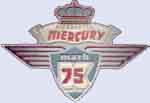The third Johnson was their grand master piece ... the TR-40 "Giant" Twin racer. Again, a 2 cylinder opposed 2 cycle with piston port intake. The Giant Twin truely was giant at 49 cubic inches. Putting out a whopping 25 3/4 hp it was a bit too much for the streamlined racing lower unit they built for it and was a little lacking on the endurance side of things. Only a few examples of the TR-40 survive today.
Mechanically the Johnson racers differed from their fishing stable mates by being equipped with narrower streamlined lower units with gear ratios allowing the propellers to turn faster, and pistons made from light weight aluminum instead of cast iron. The lighter pistons allowed the motors to rev up 500 to 1000 more rpm and make a little more power. Johnson parts books also show different part numbers for P40 and PR40 cylinders. Even though they appear the same on the outside, they are quite different internally, giving the racer a much higher compression ratio and larger exhaust ports. The early TR40's and PR40's used the same bronze connecting rods as the fishing motors, but later in 1928 they switched to a light weight steel connecting rod with roller bearings on the “big” (crankshaft) end. The KR40 fit in class A, the PR40 in class C and the TR40 in E.
I'll try to dig up some photos of these early Johnson racers.


 Thanks:
Thanks:  Likes:
Likes: 




 Reply With Quote
Reply With Quote

Bookmarks